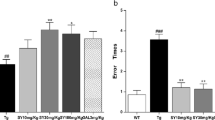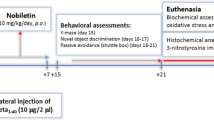Abstract
Safflower yellow (SY) is an aqueous extract of natural safflower. Our laboratory has reported protective effects of alleviating memory impairment with SY in a transgentic mouse model of Alzheimer’s disease. The possible beneficial effects of SY on amyloid-β-induced neuroinflammation in dementia remain unclarified. This study we hypothesize that astrocytes and microglia may cause amyloid-β deposition and produce a neuroinflammatory response, aims to explain the role and mechanism of SY in regulating glial activation and reducing Aβ deposition in Aβ1–42 induced rat model. Wistar rats were treated with SY for one month after bilateral hippocampal injection of aggregated Aβ1–42; behavioral tests were performed to demonstrate the amelioration of cognitive function. After that, the contents of iNOS, IL-1β, IL-6, and TNF-α in AD brain was detected. Western blot and real-time PCR were used to detect the M1 and M2-associated markers to demonstrate the activation of microglia. The conducted experiments have revealed that SY could strengthen spatial learning and memory ability of dementia rats, decrease the contents of iNOS, IL-1β, IL-6, and TNF-α and depress the activation of glial cells. Moreover, the SY treatment inhibited the M1 release of pro-inflammatory cytokines (iNOS and CD86), increased the expression of arginase-1, CD206, and YM-1 thereby reduced inflammation in model rats. Thus our results indicated that SY has very important theoretical and clinical value for the research and development of Chinese medicine for the treatment of AD.








Similar content being viewed by others
References
Bal-Price A, Brown GC (2001) Inflammatory neurodegeneration mediated by nitric oxide from activated glia-inhibiting neuronal respiration, causing glutamate release and excitotoxicity. J Neurosci 21:6480–6491
Boche D, Perry VH, Nicoll JA (2013) Review: activation patterns of microglia and their identification in the human brain. Neuropathol Appl Neurobiol 39:3–18
Couturier J, Stancu IC, Schakman O, Pierrot N, Huaux F, Kienlen-Campard P et al (2016) Activation of phagocytic activity in astrocytes by reduced expression of the inflammasome component ASC and its implication in a mouse model of Alzheimer disease. J Neuroinflammation 13:20
Cuadros MA, Santos AM, Martín-Oliva D, Calvente R, Tassi M, Marín-Teva JL et al (2006) Specific immunolabeling of brain macrophages and microglial cells in the developing and mature chick central nervous system. J Histochem Cytochem 54:727–738
Ding S (2014) Dynamic reactive astrocytes after focal ischemia. Neural Regen Res 9:2048–2052
Dodel R, Balakrishnan K, Keyvani K, Deuster O, Neff F, Andrei-Selmer LC et al (2011) Naturally occurring autoantibodies against beta-amyloid: investigating their role in transgenic animal and in vitro models of Alzheimer's disease. Journal of neuroscience the official journal of the society for. Neuroscience 31:5847–5854
Finch CE, Morgan TE (2007) Systemic inflammation, infection, ApoE alleles, and Alzheimer disease: a position paper. Curr Alzheimer Res 4:185–189
Ghosh S, Wu MD, Shaftel SS, Kyrkanides S, Laferla FM, Olschowka JA et al (2013) Sustained interleukin-1β overexpression exacerbates tau pathology despite reduced amyloid burden in an Alzheimer’s mouse model. J Neurosci 33:5053–5064
Griffin WS (2013) Neuroinflammatory cytokine signaling and Alzheimer's disease. N Engl J Med 368:770–771
Halle A, Hornung V, Petzold GC, Stewart CR, Monks BG, Reinheckel T et al (2008) The NALP3 inflammasome is involved in the innate immune response to amyloid-beta. Nat Immunol 9:857–865
Han X, Huang X, Wang Y, Chen H (2010) A study of astrocyte activation in the periinfarct region after cerebral ischemia with electroacupuncture. Brain Inj 24:773–779
Hardas SS, Sultana R, Clark AM, Beckett TL, Szweda LI, Murphy MP, Butterfield DA (2013) Oxidative modification of lipoic acid by HNE in Alzheimer disease brain. Redox Biol 1:80–85
Hu X, Li P, Guo Y, Wang H, Leak RK, Chen S et al (2012) Microglia/macrophage polarization dynamics reveal novel mechanism of injury expansion after focal cerebral ischemia. Stroke 43:3063–3070
Jeon YC, Choi JK, Choi EK, Carp RI, Kim YS (2013) Pathological characterization of TgElk mice injected with brain homogenate from elk with chronic wasting disease. J Vet Sci 14:21
Kasza Á, Penke B, Frank Z, Bozsó Z, Szegedi V, Hunya Á et al (2017) Studies for improving a rat model of Alzheimer's disease: Icv Administration of Well-Characterized β-amyloid 1-42 oligomers induce dysfunction in spatial memory. Molecules 22:2007
Li R, Wang WQ, Zhang H, Yang X, Fan Q, Christopher TA et al (2007) Adiponectin improves endothelial function in hyperlipidemic rats by reducing oxidative/nitrative stress and differential regulation of eNOS/iNOS activity. Am J Physiol Endocrinol Metab 293:1703–1708
Li J, Ma X, Wang Y, Chen C, Hu M, Wang L et al (2018) Methyl salicylate Lactoside protects neurons ameliorating cognitive disorder through inhibiting amyloid Beta-induced Neuroinflammatory response in Alzheimer's disease. Front Aging Neurosci 10:85
Liu C, Li Y, Yu J, Feng L, Hou S, Liu Y et al (2013) Targeting the Shift from M1 to M2 macrophages in experimental autoimmune encephalomyelitis mice treated with Fasudil. PLoS One 8:e54841
Liu Z, Zhao X, Liu B, Liu AJ, Li H, Mao X et al (2014) Jujuboside a, a neuroprotective agent from semen Ziziphi Spinosae ameliorates behavioral disorders of the dementia mouse model induced by Aβ 1-42. Eur J Pharmacol 738:206–213
Ma Q, Ruan YY, Xu H, Shi XM, Wang ZX, Hu YL (2015) Safflower yellow reduces lipid peroxidation, neuropathology, tau phosphorylation and ameliorates amyloid β-induced impairment of learning and memory in rats. Biomed Pharmacother 76:153–164
Mawuenyega KG, Sigurdson W, Ovod V, Munsell L, Kasten T, Morris JC et al (2010) Decreased clearance of CNS beta-amyloid in Alzheimer's disease. Science 330:1774
Murphy S, Simmons ML, Agullo L, Garcia A, Feinstein DL, Galea E et al (1993) Synthesis of nitric oxide in CNS glial cells. Trends Neurosci 16:323–328
Ohsawa K, Imai Y, Kanazawa H, Sasaki Y, Kohsaka S (2000) Involvement of Iba1 in membrane ruffling and phagocytosis of macrophages/microglia. J Cell Sci 113(Pt 17):3073–3084
Pisanu A, Lecca D, Mulas G, Wardas J, Simbula G, Spiga S et al (2014) Dynamic changes in pro- and anti-inflammatory cytokines in microglia after PPAR-γ agonist neuroprotective treatment in the MPTPp mouse model of progressive Parkinson's disease. Neurobiol Dis 71:280–291
Ramirez AI, Hoz RD, Salobrargarcia E, Salazar JJ, Rojas B, Ajoy D et al (2017) The role of microglia in retinal neurodegeneration: Alzheimer's disease, Parkinson, and glaucoma. Front Aging Neurosci 9:214
Ruan YY, Zhai W, Shi XM, Zhang L, Hu YL (2016) Safflower yellow ameliorates cognition deficits and reduces tau phosphorylation in APP/PS1 transgenic mice. Metab Brain Dis 31:1–10
Sastre M, Dewachter I, Rossner S, Bogdanovic N, Rosen E, Borghgraef P et al (2006) Nonsteroidal anti-inflammatory drugs repress beta-secretase gene promoter activity by the activation of PPARgamma. Proc Natl Acad Sci U S A 103:443–448
Shi XM, Zhang H, Zhou ZJ, Ruan YY, Pang J, Zhang L et al (2017) Effects of safflower yellow on beta-amyloid deposition and activation of astrocytes in the brain of APP/PS1 transgenic mice. Biomed Pharmacother 98:553–565
Tweedie D, Ferguson RA, Fishman K, Frankola KA, Praag HV, Holloway HW et al (2012) Tumor necrosis factor-α synthesis inhibitor 3,6′-dithiothalidomide attenuates markers of inflammation, Alzheimer pathology and behavioral deficits in animal models of neuroinflammation and Alzheimer’s disease. J Neuroinflammation 9:106–122
Wang G, Zhang J, Hu X, Zhang L, Mao L, Jiang X et al (2013) Microglia/macrophage polarization dynamics in white matter after traumatic brain injury. J Cereb Blood Flow Metab 33:1864–1874
Wang X, Wang L, Jiang R, Yuan Y, Yu Q, Li Y (2015) Exendin-4 antagonizes Aβ1-42-induced suppression of long-term potentiation by regulating intracellular calcium homeostasis in rat hippocampal neurons. Brain Res 1627:101–108
Zheng Z, Yenari MA (2004) Post-ischemic inflammation: molecular mechanisms and therapeutic implications. Neurol Res 26:884–892
Acknowledgements
This research was supported by the Project of Social Development of the Corps (No. 2016 AD001), Natural Science Foundation of China (No. 81660603).
Author information
Authors and Affiliations
Corresponding author
Ethics declarations
Animal studies
Animals were treated according to the guidelines of Animal Management Rules of the Ministry of Health of the People’s Republic of China (documentation Number 55, 2001, Ministry of Health of PR China). The experiments were approval by the Committee of Experimental Animal Administration of Shihezi University.
Conflict of interests
The authors declare that they have no conflict of interest.
Additional information
Publisher’s note
Springer Nature remains neutral with regard to jurisdictional claims in published maps and institutional affiliations.
Rights and permissions
About this article
Cite this article
Zhang, L., Zhou, Z., Zhai, W. et al. Safflower yellow attenuates learning and memory deficits in amyloid β-induced Alzheimer’s disease rats by inhibiting neuroglia cell activation and inflammatory signaling pathways. Metab Brain Dis 34, 927–939 (2019). https://doi.org/10.1007/s11011-019-00398-0
Received:
Accepted:
Published:
Issue Date:
DOI: https://doi.org/10.1007/s11011-019-00398-0




